This article focuses on a factual, comprehensive piece that reviews the top 15 nutritionally ranked dishes from various cuisines. The scope emphasizes why each dish shines for health benefits and outlines easy upgrade suggestions to improve fiber, micronutrient content, and overall nutritional balance.
1. Introduction
In today’s fast-evolving world of culinary diversity and dietary awareness, food is no longer merely a source of sustenance—it is a gateway to long-term health, cultural identity, and a balanced lifestyle. This article presents an in-depth nutritional overview of the top 15 global dishes ranked by their inherent health benefits. Combining insights from various scientific sources, industry expertise, and communal experiences, we critically assess each dish’s nutritional strengths, potential health watch-outs, and provide easy upgrade suggestions that allow for both maintaining tradition and enhancing overall nutritional value.
Grounded in evidence from health authorities and nutritional studies—such as those outlined by Healthline on super healthy whole foods and discussions on traditional and upgraded meals from community platforms like Quora and Reddit—this research emphasizes foods rich in lean proteins, whole grains, fibers, micronutrients, and healthy fats. The integration of cultural cuisine and modern dietary science paves the way for sustainable eating practices that do not compromise on taste, tradition, or nutritional adequacy.
2. Nutritional Analysis of Top 15 Global Dishes and Their Upgrades
In this section, each dish has been carefully analyzed based on its primary ingredients and cultural preparation methods. We focus on key nutritional features derived from lean proteins, whole grains, vegetables, and fermented elements, while addressing common areas of concern such as sodium content or saturated fats. Easy upgrade suggestions are provided to encourage the integration of additional micronutrients, lower potentially harmful components, and improve overall dietary diversity.
15. Vietnamese Pho
Vietnamese Pho, a traditional noodle soup, occupies the 15th rank in our nutritional standing. It is celebrated worldwide for its aromatic broth, which is often prepared from lean beef or chicken and enriched with a variety of herbs and spices.
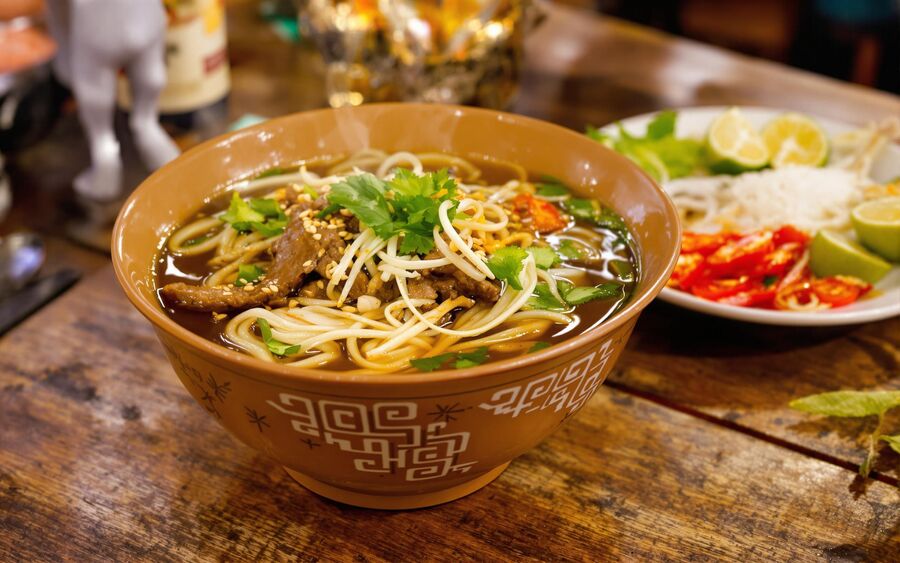
Why It Shines:
- Lean Protein Source: Vietnamese Pho commonly features lean meats like beef or chicken that contribute to essential protein intake without excessive saturated fats, aligning with recommendations for incorporating quality protein sources into one’s diet.
- Nutrient-Rich Broth: The slow-simmered bone broth contains minerals and collagen that support joint health, skin vitality, and overall nutrient density.
- Herbs & Spices: The inclusion of basil, cilantro, and lime offers antioxidants and additional micronutrients such as vitamin C, which boosts the immune system.
Nutritional Watch-outs:
- Sodium Level: Traditional versions may contain high sodium levels, especially when using pre-prepared broths or seasoning packets, potentially raising concerns for cardiovascular health.
- Carbohydrate Considerations: The rice noodle base, while gluten-free, might offer high glycemic values unless balanced with adequate protein and fiber.
Easy Upgrade Suggestions:
- Vegetable Enrichment: Swap traditional rice noodles for zucchini noodles or add extra leafy greens to boost both vitamin and fiber content, following strategies suggested on community platforms for food upgrades.
- Low-Sodium Options: Prepare homemade broth with low-sodium ingredients and emphasize fresh herbs to ensure flavor without excessive salt.
- Whole-Grain Variations: Consider experimenting with brown rice noodles to offer a more slowly digestible carbohydrate option.
14. Peruvian Ceviche
Peruvian Ceviche is renowned for its refreshing combination of raw fish, citrus juices, and vibrant vegetables. This dish stands out for its minimal processing and emphasis on fresh, high-quality ingredients.
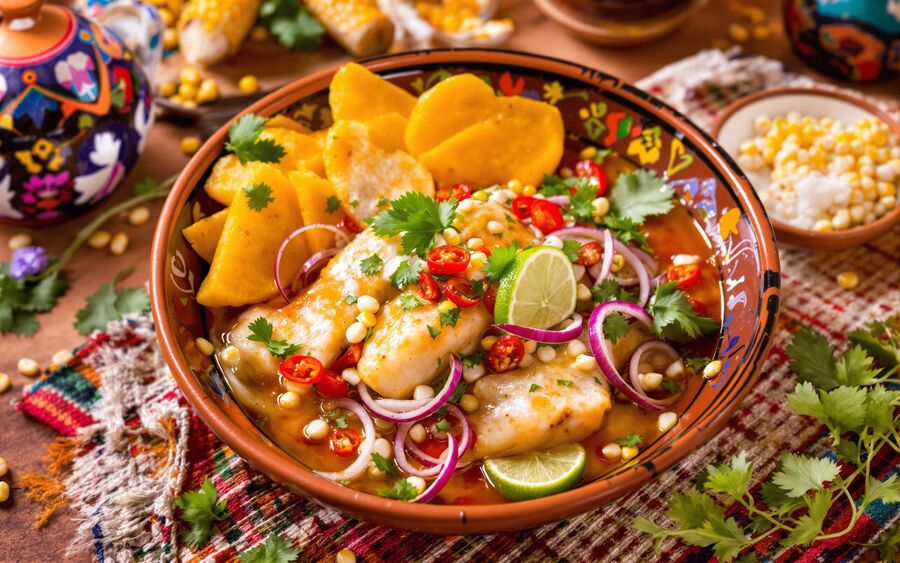
Why It Shines:
- High-Quality Seafood: As a lean protein, the raw fish in ceviche is rich in omega-3 fatty acids, contributing to heart and brain health.
- Vitamin C Boost: The generous use of lime or lemon juice not only preserves the fish but also provides a significant source of vitamin C, promoting immune function and collagen synthesis.
- Low-Calorie Base: The dish is naturally low in calories and free from heavy sauces, making it suitable for weight management and a nutrient-dense diet.
Nutritional Watch-outs:
- Food Safety: Due to the raw fish component, ensuring freshness and proper handling is crucial to minimize risks of foodborne illness.
- Acidity Concerns: Excessive citrus usage may pose challenges for individuals with acid reflux; controlled portions can mitigate these risks.
Easy Upgrade Suggestions:
- Crisp Vegetable Additions: Introduce finely chopped cucumbers, red onions, or radishes to increase fiber and assorted micronutrients, as recommended by user upgrades on various cooking forums.
- Enhanced Omega-3 Profile: While the fish already provides omega-3s, topping with a sprinkle of chia seeds or ground flaxseeds can further boost these beneficial fats.
- Balanced Acidity: Use a mix of citrus juice with a mild vegetable base to reduce over-acidity while preserving flavor.
13. Fonio with Moringa & Groundnut Stew
Fonio, an ancient West African grain, is paired with moringa leaves and a groundnut-rich stew in this dish. Known for its traditional preparation and high nutrient profile, this dish represents both historical and modern dietary solutions.
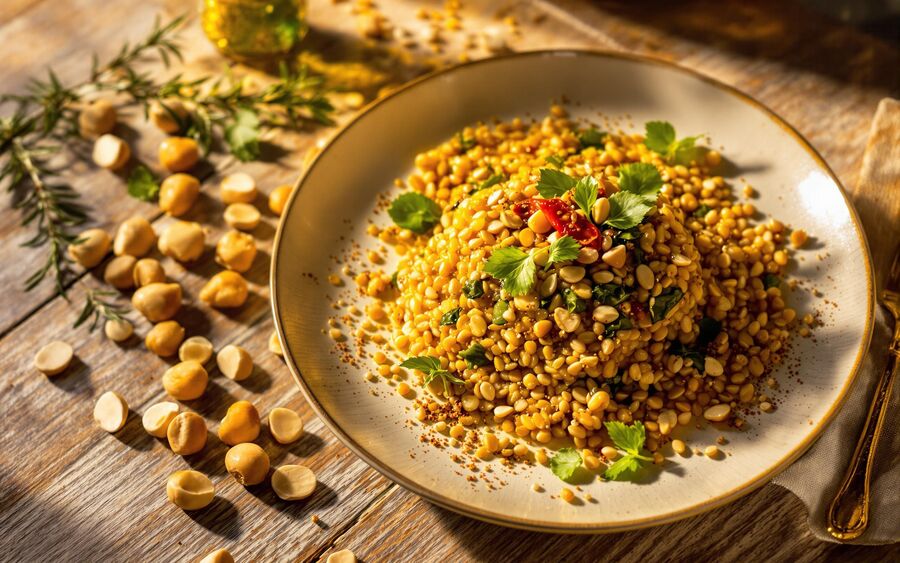
Why It Shines:
- Ancient Grain Benefits: Fonio is a gluten-free grain rich in fiber, essential amino acids, and minerals, echoing Healthline’s emphasis on nutrient-dense whole grains.
- Nutrient-Dense Moringa: Moringa leaves, a celebrated superfood, provide a wide spectrum of vitamins (including vitamins A and C) and minerals (such as calcium and potassium), contributing to a robust nutritional profile.
- Healthy Fats from Groundnuts: The groundnut component introduces unsaturated fats that align with heart-healthy dietary guidelines while enhancing flavor and satiety.
Nutritional Watch-outs:
- Sodium and Calorie Density: Stews can sometimes be high in sodium if overly salted; a careful balance is required. Similarly, the calorie density might be high for those needing to restrict intake.
- Allergen Awareness: Groundnuts are a known allergen and should be substituted or omitted for sensitive individuals.
Easy Upgrade Suggestions:
- Low-Sodium Preparation: Use natural herbs and spices to enhance flavor without excess salt.
- Vegetable Enrichment: Incorporate tomatoes, okra, or additional leafy greens to further boost fiber and vitamin content.
- Whole-Grain Refinement: Consider a mix of fonio with other whole grains (such as quinoa) to provide varied textures and nutritional depth.
12. Sabzi Polo-ye Mahi
Originating from the Persian culinary tradition, Sabzi Polo-ye Mahi pairs aromatic herbed rice with white fish. This dish is both visually appealing and nutritionally balanced due to its mix of lean proteins, herbs, and complex carbohydrates.
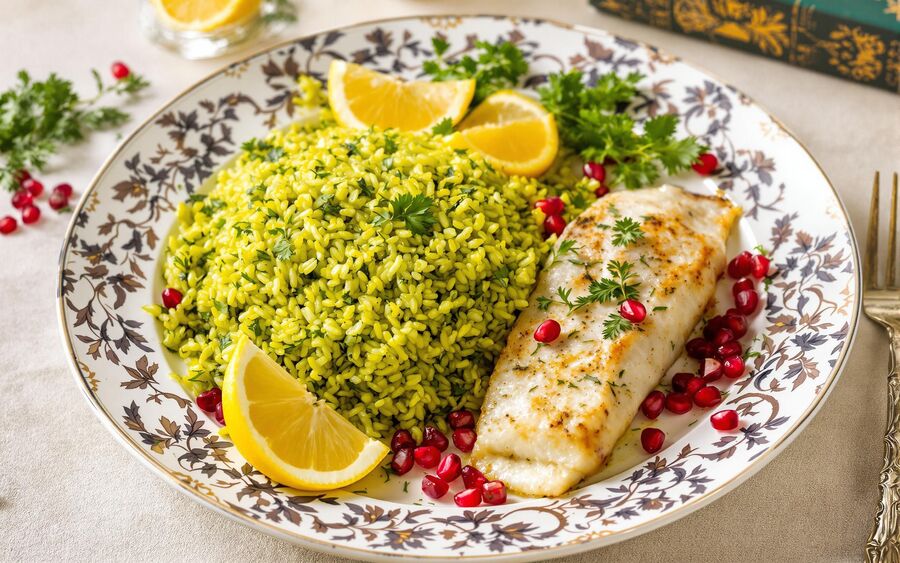
Why It Shines:
- Lean White Fish: White fish, typically low in fat, offers a lean source of protein essential for muscle maintenance and overall metabolic health.
- Herbed Rice Excellence: The rice is enriched with fresh herbs like dill and parsley, which pack antioxidants and contribute to a reduction in oxidative stress.
- Cultural Value and Balance: The dish is appreciated not only for its delightful flavor but also for its balanced composition of proteins, carbohydrates, and micronutrients.
Nutritional Watch-outs:
- Refined Rice Concerns: Regular white rice may be lower in fiber compared to whole-grain options. Upgrading to brown rice or mixing with lentils can offer better glycemic control.
- Seasoning Pitfalls: Excessive use of salt-based seasonings may raise sodium levels, necessitating moderation in seasoning.
Easy Upgrade Suggestions:
- Whole-Grain Integration: Replace or partly mix white rice with lentils or brown rice to boost fiber and maintain low glycemic load.
- Herbal Intensification: Increase the quantity of fresh herbs like cilantro and basil to further enrich the dish with vitamins and antioxidants.
- Complementary Vegetables: Serve with a side of steamed or lightly sautéed vegetables to improve the meal’s overall nutritional profile.
11. Greek Horiatiki + Grilled Sardines & Dakos
This Mediterranean marvel combines the rustic appeal of Greek Horiatiki (village salad) with the nutrient-rich offerings of grilled sardines and dakos—a crisp barley rusk. It perfectly embodies the beneficial elements of a Mediterranean diet.
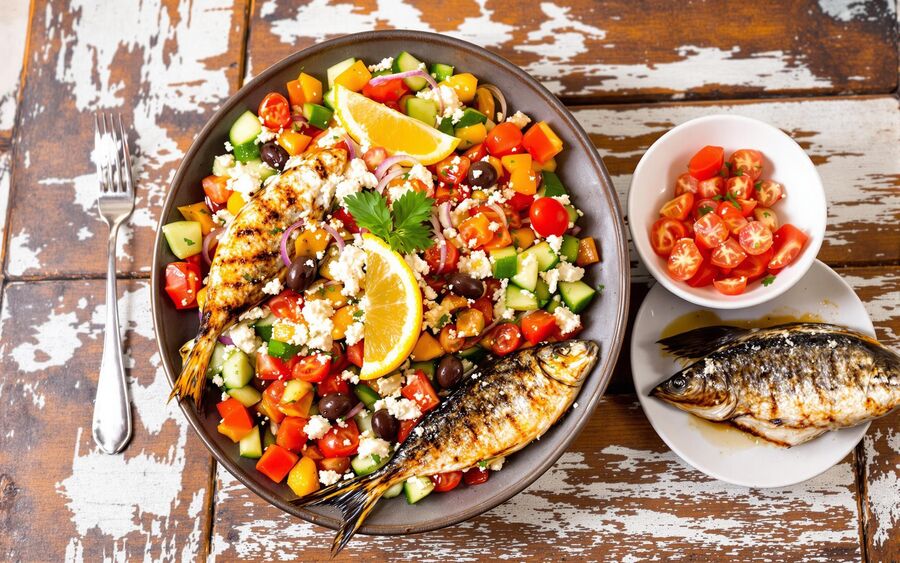
Why It Shines:
- EVOO and Fresh Vegetables: Extra virgin olive oil, a hallmark of the Mediterranean diet, is celebrated for its heart-healthy monounsaturated fats, antioxidant properties, and anti-inflammatory benefits.
- Omega-3 Rich Sardines: Sardines are an excellent option for omega-3 fatty acids, which support cardiovascular health and reduce inflammation.
- Fiber and Whole-Grain Benefits: Dakos provides extra crunch and fiber while linking traditional breads to modern whole-grain nutrition principles.
Nutritional Watch-outs:
- Caloric Density of Oils: Although EVOO is healthy, its dense caloric content may require careful portion control in calorie-sensitive diets.
- Potential Allergens: Seafood allergies must be managed with careful selection or substitution of sardines if necessary.
Easy Upgrade Suggestions:
- Legume Incorporation: Add a side of cooked legumes (like chickpeas or lentils) to increase protein and fiber, which can help balance the fats from oil.
- Alternative Bread Bases: Experiment with whole-grain crackers or baked seed-based crisps instead of dakos to further elevate the nutrient profile.
- Fresh Produce Emphasis: Increase the ratio of fresh vegetables in the salad to ensure an even higher intake of vitamins, minerals, and antioxidants.
10. Japanese Teishoku
Japanese Teishoku represents a typical set meal that is meticulously balanced, featuring a main protein, side dishes, miso soup, and rice. Its balance of flavors and nutritional components has made it a favorite among those seeking a wholesome meal.
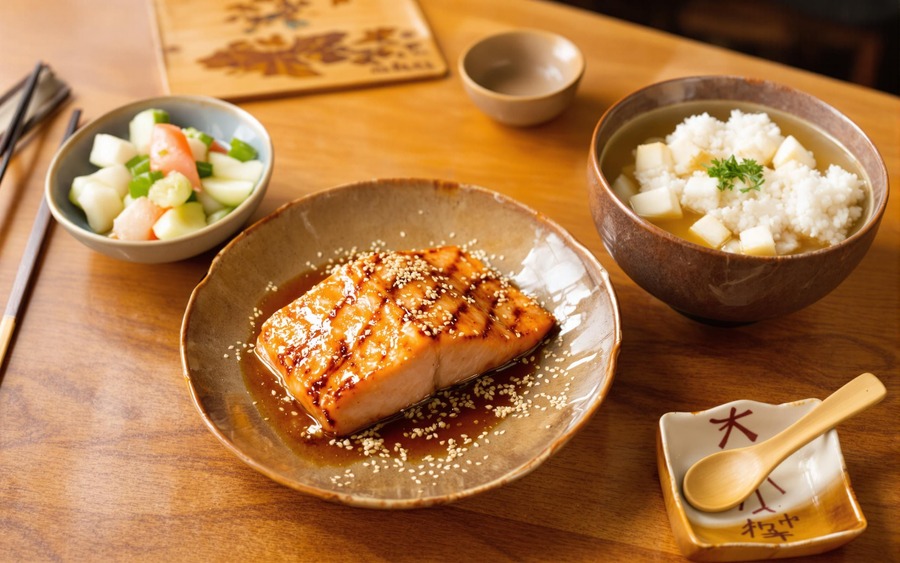
Why It Shines:
- Fermented Miso Soup: Miso, a staple in Japanese cuisine, is rich in probiotics and essential enzymes that enhance gut health and aid digestion.
- Lean Protein Options: Protein sources such as grilled fish or tofu provide essential amino acids with minimal saturated fats.
- Whole-Grain Rice: Traditional white rice is complemented by occasional brown rice or mixed grains for improved fiber content, as recommended by modern dietary upgrades.
Nutritional Watch-outs:
- High Sodium in Soup: Miso soup, while beneficial, may be high in sodium, especially when consumed in large portions.
- Carbohydrate Load: The predominantly rice-based meal may benefit from additional vegetable or legume content to balance the macronutrient profile.
Easy Upgrade Suggestions:
- Brown Rice Swap: Substitute white rice with brown rice or a mixed-grain alternative to enhance the meal’s fiber profile and nutritional complexity.
- Vegetable-Rich Side Dishes: Incorporate additional seasonal vegetables into side dishes to further support micronutrient intake.
- Light Soy Sauce Alternatives: Use reduced-sodium soy sauce or tamari in dressings and marinades to lower overall sodium levels without sacrificing flavor.
9. Nordic Salmon-on-Rye Plate
Representing the culinary traditions of Northern Europe, the Nordic Salmon-on-Rye Plate combines the nutritional benefits of salmon with the hearty, fiber-rich quality of rye bread and the probiotic support of pickled vegetables.
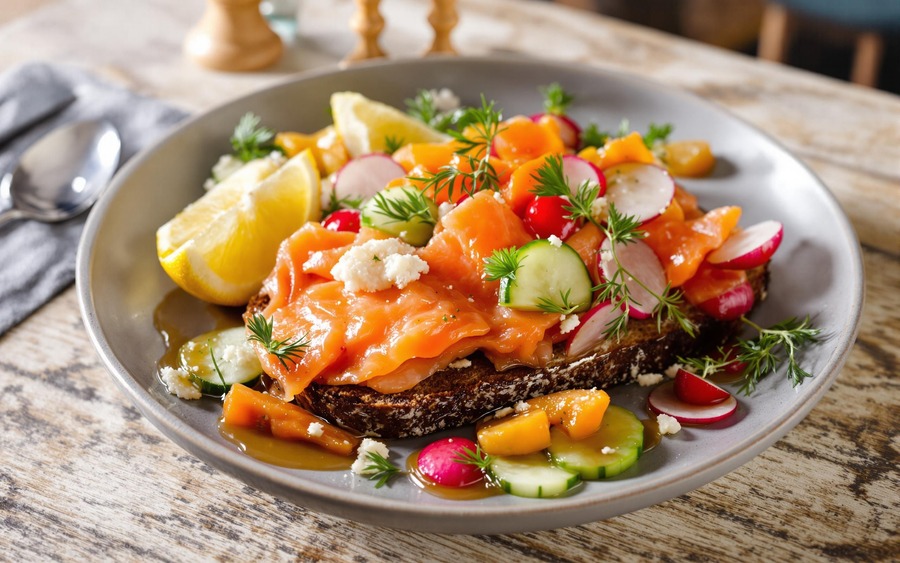
Why It Shines:
- Omega-3 Powerhouse: Salmon is celebrated for its robust omega-3 fatty acid content, which is linked to cardiovascular health and anti-inflammatory benefits.
- Whole-Grain Rye Bread: Rye is a superior source of dietary fiber, which supports digestive health and provides sustained energy release.
- Probiotic Pickles: Accompanying pickled vegetables deliver probiotics that boost gut health and enhance overall digestion.
Nutritional Watch-outs:
- Carbohydrate Quality: While rye is beneficial, portions should be monitored for total carbohydrate intake, particularly for those requiring glycemic control.
- Sodium in Pickles: As with many fermented foods, pickled vegetables can be high in sodium; moderation or low-sodium versions are advisable.
Easy Upgrade Suggestions:
- Enhanced Fiber Options: Pair the plate with a colorful side salad using raw or lightly steamed greens to further increase fiber and antioxidant intake.
- Nutritious Spreads: Use avocado as a spread on rye bread to provide additional healthy fats and reduce reliance on high-sodium butter or margarine alternatives.
- Homemade Pickles: Consider making homemade pickles with reduced salt content to tailor the meal’s overall sodium content without sacrificing probiotic benefits.
8. Pre-Hispanic Mexican Bowl
The Pre-Hispanic Mexican Bowl is a modern reinterpretation of ancient ingredients, combining beans, corn, avocado, and vegetables into a nutrient-rich bowl that celebrates indigenous flavors and nutritional balance.
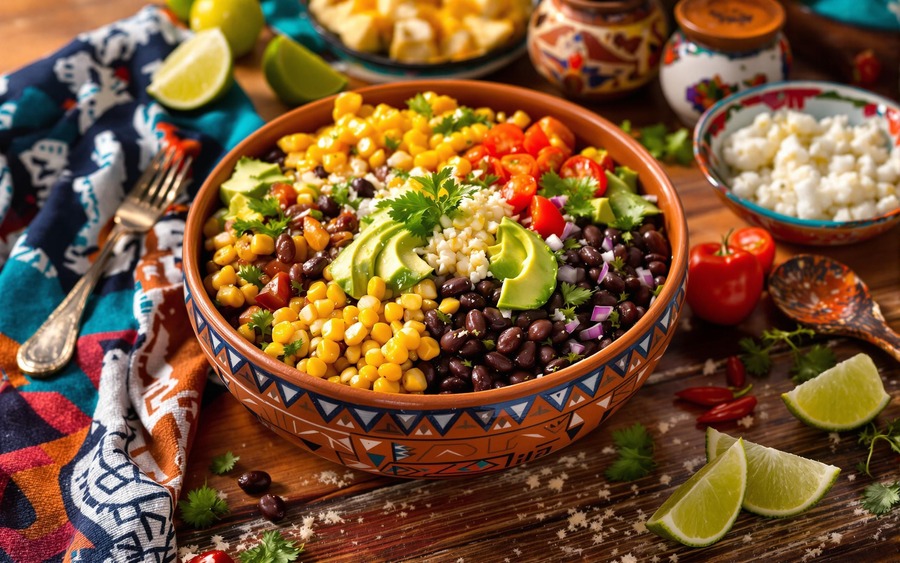
Why It Shines:
- Legumes and Whole Grains: Beans and corn provide complex carbohydrates, fiber, and plant-based protein, which are essential for a balanced, nutrient-dense diet.
- Avocado’s Healthy Fats: Avocado contributes monounsaturated fats that support heart health and offer a rich array of vitamins, including vitamins C and E.
- Micronutrient Diversity: The colorful mix of vegetables ensures a wide spectrum of micronutrients, aligning with the concept of a “powerhouse” food distribution by modern health guidelines.
Nutritional Watch-outs:
- Portion Control: Corn-based ingredients should be moderated to avoid excessive carbohydrate intake, and preparation methods must avoid added sugars or unhealthy fats.
- Sodium Management: Preparing dressings and seasoning from scratch helps control sodium levels while preserving traditional flavors.
Easy Upgrade Suggestions:
- Super Greens Addition: Incorporating nopales (cactus paddles) or adding a sprinkle of chia seeds can elevate the fiber and antioxidant content significantly.
- Cultural Adaptations: Experiment with replacing some of the corn with quinoa, another ancient grain that provides additional protein and micronutrients.
- Fresh Salsa Alternatives: Use fresh, unsalted tomatoes, onions, and lime to make a salsa that enhances flavor and nutritional value without additional preservatives.
7. Mujadara & Fattoush
Mujadara and Fattoush are traditional Middle Eastern dishes that together provide a robust mix of lentils, rice, and fresh vegetables, making them a culinary symbol of balanced nutrition and cultural heritage.
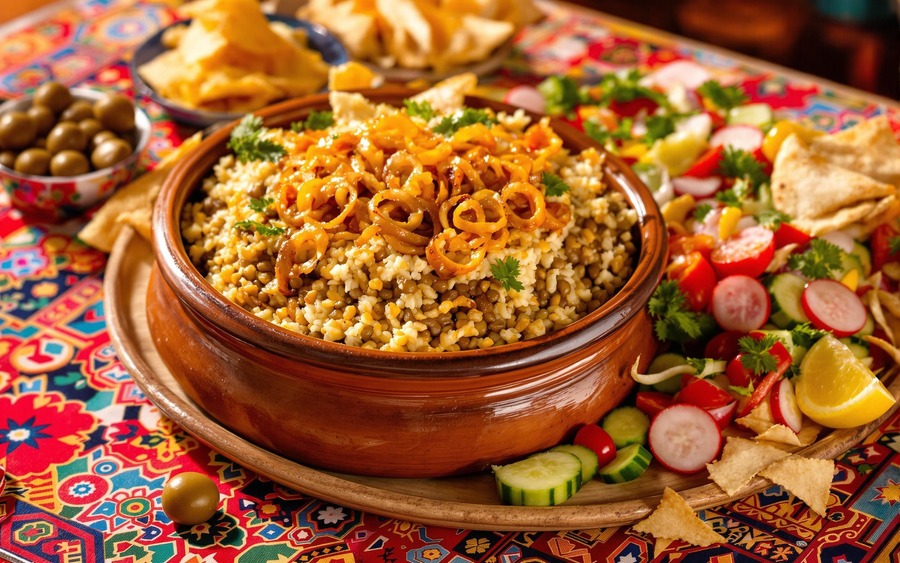
Why It Shines:
- Legume Superiority: Mujadara is based on lentils—a rich source of protein, fiber, and essential B vitamins, contributing significantly to sustained energy and digestive health.
- Raw Vegetable Goodness: Fattoush, a fresh salad made of tomatoes, cucumbers, radishes, and herbs, provides an array of vitamins, antioxidants, and minerals, aligning with modern nutritional guidelines for diverse micronutrient intake.
- Healthy Fats: A drizzle of extra virgin olive oil in the salad enhances the dish’s absorption of fat-soluble vitamins and delivers cardiovascular benefits.
Nutritional Watch-outs:
- Carbohydrate Balance: While lentils and rice offer a steady release of energy, careful portion control is needed to maintain optimal glycemic levels.
- Oil Quantities: Using moderate amounts of olive oil is critical to prevent an excess of calories while still providing the beneficial unsaturated fats.
Easy Upgrade Suggestions:
- Grain Alternatives: Substitute part of the white rice with whole grains like bulgur or quinoa for increased fiber and a lower glycemic load.
- Herb Boost: Increase the use of fresh herbs—mint, parsley, and cilantro—to amplify micronutrient density and flavor without extra calories.
- Protein Additions: A small topping of grilled lean meat or tofu can further balance the macronutrients and convert the dish into a more complete meal.
6. Okinawan Sweet-Potato & Goya Champuru
A cornerstone of Okinawan cuisine, this dish combines sweet potatoes and bitter gourd (goya) with tofu in a stir-fry that is famed for its longevity-promoting qualities and balanced nutrient profile.
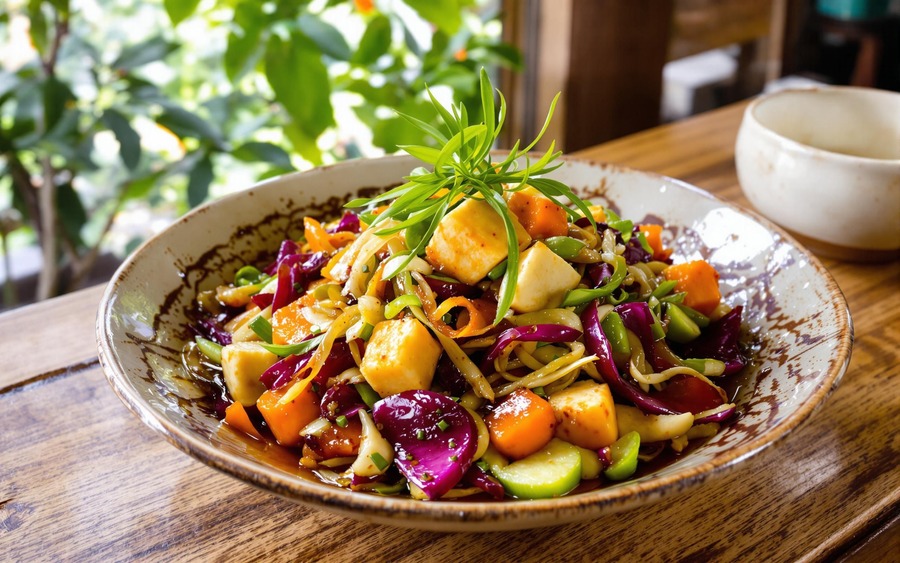
Why It Shines:
- High Fiber Content: Sweet potatoes bring abundant dietary fiber, vitamins (notably vitamin A and C), and complex carbohydrates that support sustained energy and digestive health.
- Antioxidant-Rich Veggies: Goya (bitter gourd) is renowned for its bitter compounds that are linked to blood sugar regulation and metabolic benefits.
- Plant-Based Protein: Tofu provides complete plant-based protein while contributing calcium and iron in a low-saturated fat package.
Nutritional Watch-outs:
- Sodium in Sauces: Soy sauce and other condiments in stir-fries can add up in sodium content if not monitored.
- Bitter Taste Balance: The inherent bitterness of goya, while beneficial, may require balancing with complementary flavors to appeal to all palates.
Easy Upgrade Suggestions:
- Low-Sodium Alternatives: Utilize low-sodium soy sauce and fresh ginger to maintain flavor while reducing overall sodium intake.
- Whole Food Additions: Incorporate extra leafy greens such as spinach or kale to further boost fiber and micronutrient diversity.
- Healthy Cooking Methods: Opt for steaming or lightly stir-frying rather than deep-frying to preserve the nutritional integrity of the ingredients.
5. Korean Bibimbap with Kimchi
Korean Bibimbap is a vibrant, mixed rice bowl that epitomizes balanced nutrition, combining a variety of vegetables, lean proteins, and fermented elements like kimchi.
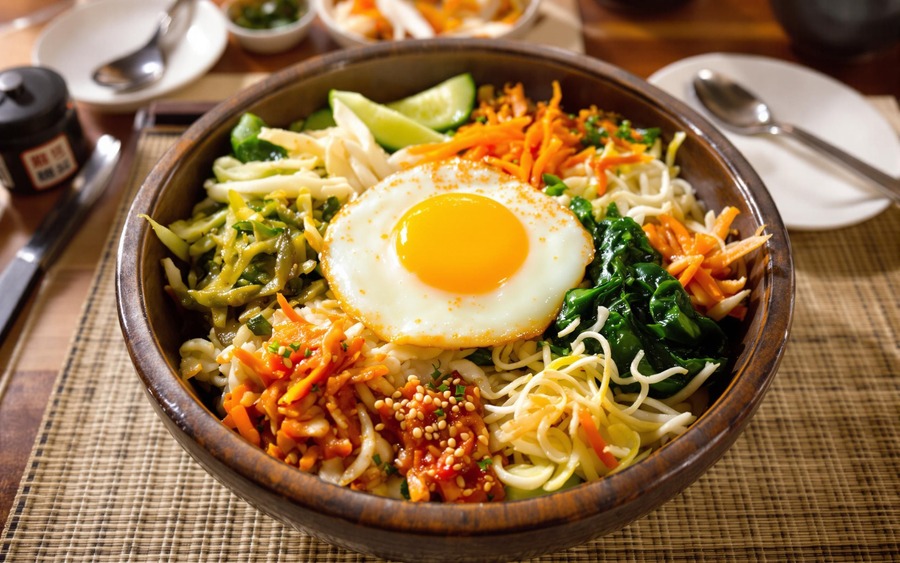
Why It Shines:
- Variety of Vegetables: Bibimbap is filled with assorted vegetables—each contributing specific micronutrients, vitamins, and antioxidants that enhance overall digestive and metabolic health.
- Fermented Kimchi: Kimchi adds probiotic benefits that support gut health and aid in the absorption of nutrients. Its fermentation aligns well with recommendations noting the importance of probiotics in traditional diets.
- Whole Grains: Serving the dish with brown rice instead of white rice enhances fiber intake and lowers the glycemic index, making it a more balanced meal option.
Nutritional Watch-outs:
- Sodium in Kimchi: While beneficial, kimchi’s high sodium content warrants moderation or selecting lower-sodium versions.
- Balanced Composition: Given the carbohydrate-rich nature of rice, ensuring a proportional mix of proteins and vegetables is essential.
Easy Upgrade Suggestions:
- Brown Rice Adoption: Use brown rice or multi-grain blends to provide a higher fiber content and slower digestion rate.
- Enhanced Vegetable Ratio: Increase the quantity and variety of vegetables to further improve antioxidant density and nutrient diversity.
- Lean Protein Options: Consider topping the dish with extra lean proteins such as tofu or grilled chicken to boost satiety and balance the meal’s macronutrient profile.
4. Mediterranean Mezze Plate
The Mediterranean Mezze Plate is a vibrant collection of small dishes including hummus, baba ganoush, olives, and fresh vegetables, collectively offering a canvas rich in healthy fats, fibers, and antioxidants.
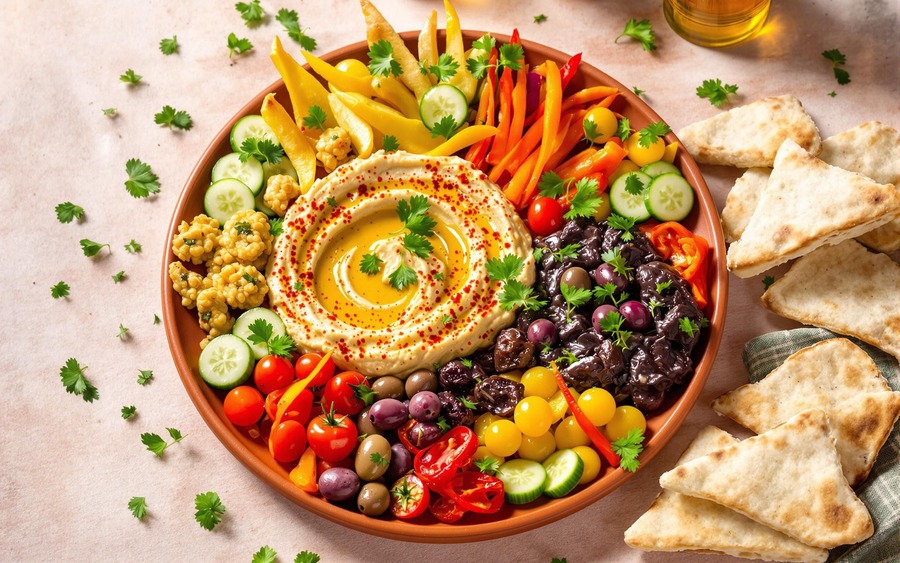
Why It Shines:
- Diverse Nutrient Sources: With items ranging from legumes and nuts to vegetables, the mezze plate provides a comprehensive array of vitamins, minerals, and phytonutrients that support heart and cognitive health.
- Healthy Fats: The use of olive oil and nuts ensures a predominance of unsaturated fats, which are critical for lowering cholesterol and reducing inflammation.
- Cultural and Culinary Integration: This plate not only supports health but also celebrates cultural traditions and the communal aspects of dining.
Nutritional Watch-outs:
- Portion Size Management: Given the multiple components typical of a mezze plate, portion control is crucial to avoid excessive calorie intake.
- Salt Content: Olives and certain dips may be high in salt; balancing these with fresh fruits and vegetables is recommended.
Easy Upgrade Suggestions:
- Low-Salt Preparations: Prepare dips and spreads at home using fresh ingredients to control added salt while preserving flavor.
- Increased Raw Vegetable Serve: Supplement the plate with additional raw vegetables, such as carrot or celery sticks, to further enhance fiber and micronutrient intake.
- Integration of Legumes: Add a small serving of fava beans or chickpeas to enrich the protein and fiber content of this nutrient-rich spread.
3. South-Indian Thali
South-Indian Thali is a complete meal comprising spiced lentil soup (sambar)/Dal , rice, vegetable dishes, and sometimes a side of yogurt. It represents the epitome of balanced nutrition by combining proteins, complex carbohydrates, and a kaleidoscope of vegetables.
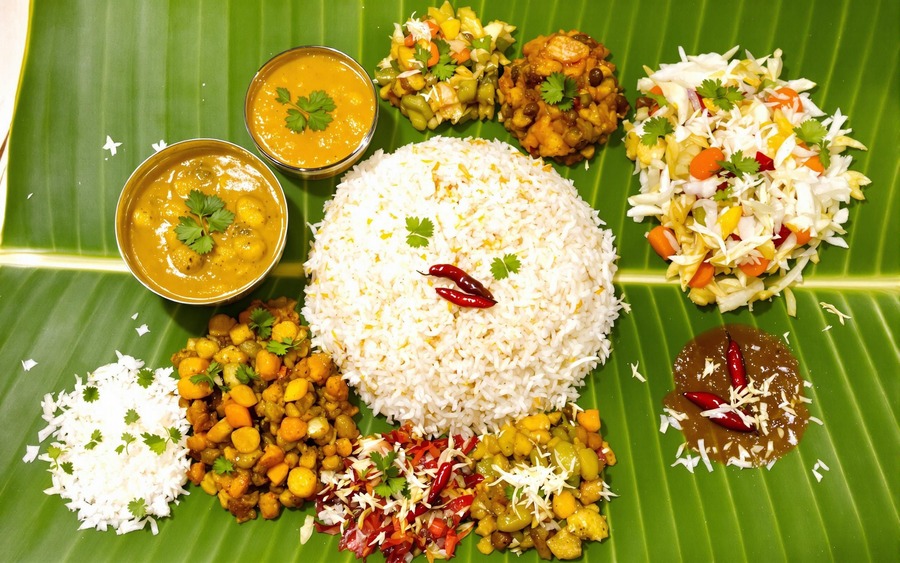
Why It Shines:
- Legume Power: Sambar’s base of lentils is an excellent source of protein, fiber, and essential minerals, making it an ideal inclusion for plant-based diets.
- Spice and Phytochemical Richness: Spices such as turmeric, cumin, and coriander not only add flavor but also provide anti-inflammatory and antioxidant benefits.
- Balanced Meal Structure: The inclusion of rice, vegetable curries, and yogurt ensures a balanced harmony of macronutrients and a robust supply of calcium and probiotics.
Nutritional Watch-outs:
- Saturated Fat Caution: The use of ghee in some preparations can increase saturated fat intake, calling for cautious usage or substitution with healthier fats.
- Glycemic Considerations: White rice, if used extensively, may lead to higher glycemic responses; thus, it should be balanced with fiber-rich vegetables.
Easy Upgrade Suggestions:
- Low-Fat Cooking Methods: Replace ghee or oil with heart-healthy oils such as extra virgin olive oil or avocado oil where possible.
- Whole-Grain Rice Variants: Substitute white rice with brown rice or millets to offer additional fiber and a lower glycemic index.
- Spice Optimization: Introduce fresh ginger and garlic to naturally boost flavor and nutrient absorption while reducing the dependency on refined additives.
2. Modern Buddha/Grain Bowl
Reflecting contemporary dietary trends while retaining traditional wisdom, the Modern Buddha/Grain Bowl is a customizable, nutrient-dense meal that allows for endless variations to suit personal preferences and nutritional requirements.
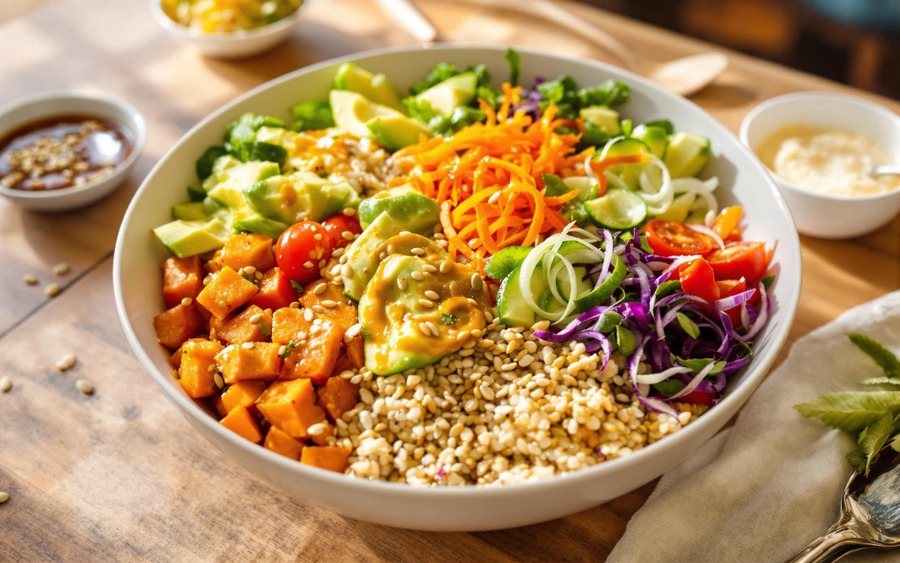
Why It Shines:
- Diverse Vegetable Intake: Packed with fresh, seasonal vegetables, the bowl ensures a wide variety of essential vitamins, minerals, and antioxidants, supporting overall wellness and immune function.
- Whole Grains and Legumes: The inclusion of whole grains such as quinoa, brown rice, or farro, along with legumes, provides a balanced source of complex carbohydrates and protein that stabilizes blood glucose levels.
- Flexibility for Customization: Modern dietary trends favor self-customizable meal bowls because they allow individuals to tailor their meals based on dietary needs, taste preferences, and nutritional gaps.
Nutritional Watch-outs:
- Calorie Balancing: With the freedom of customization comes the risk of overloading on calorie-dense ingredients (e.g., dressings or excessive avocados), necessitating careful portion control.
- Sodium in Pre-Made Components: Ingredients such as store-bought dressings or pre-cooked grains may contain added salt, which needs moderation.
Easy Upgrade Suggestions:
- Homemade Dressings: Prepare dressings from scratch using extra virgin olive oil, lemon juice, and herbs to lower unnecessary additives.
- Protein Boost: Add a generous portion of lean proteins—such as grilled tofu, tempeh, or white fish—to ensure proper satiety and a balanced amino acid profile.
- Superfood Enhancements: Top the bowl with nutrient-dense seeds (chia, flax, or pumpkin seeds) to further elevate the micronutrient profile and provide healthy omega fatty acids.
1. Ethiopian Injera with Mixed Wot
Topping our nutritional ranking, Ethiopian Injera with Mixed Wot is an exemplary dish that combines the benefits of fermented whole grains with the robust flavors of spicy stews laden with legumes and vegetables.
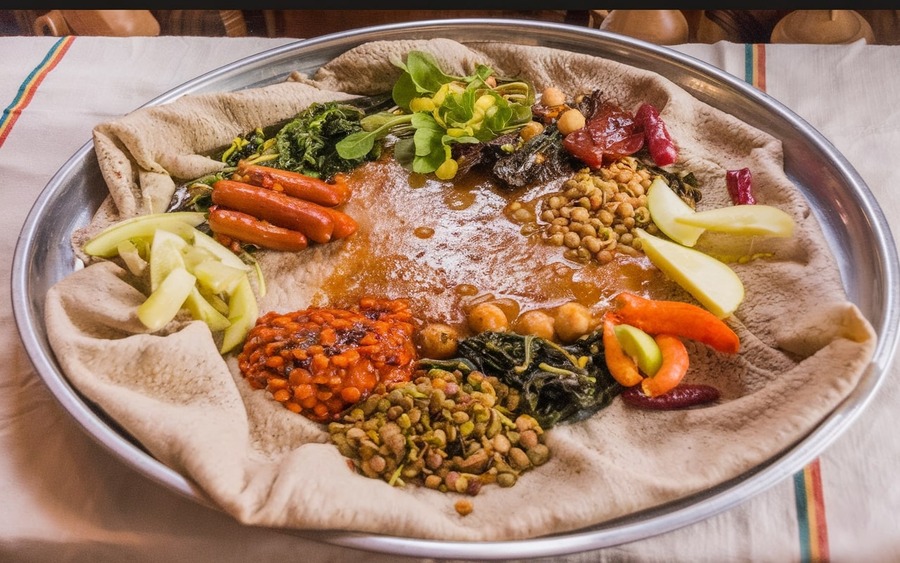
Why It Shines:
- Fermented Nutritional Power: Injera, made from teff—a tiny, nutrient-dense grain—is naturally fermented, which increases the bioavailability of nutrients and introduces beneficial probiotics that bolster gut health.
- Micronutrient-Rich Stew: Mixed Wot, a variety of spicy stews, often includes lentils, vegetables, and lean meats that contribute a diverse blend of micronutrients such as iron, calcium, and vitamin A.
- Cultural and Dietary Balance: This dish is a stellar representation of traditional culinary heritage merged with modern nutritional insights, highlighting whole grains, legumes, and fermented foods as cornerstones for a balanced diet.
Nutritional Watch-outs:
- Carbohydrate Intensity: Due to its reliance on a grain-heavy base, portion management is important for those monitoring carbohydrate intake.
- Spice Intensity: The spice mix, while culturally authentic, may need moderation for individuals sensitive to heat or those with digestive concerns.
Easy Upgrade Suggestions:
- Enhanced Fiber Additions: Prior to serving, mix in additional lightly steamed vegetables like leafy greens or carrots with the wot to raise the fiber and vitamin content.
- Low-Sodium Spice Alternatives: Adjust traditional salt-heavy spice mixes using herbs and citrus to maintain flavor while reducing sodium concentration.
- Integration of Lean Proteins: Encourage the use of lean proteins such as chicken or turkey in the wot to complement the inherent nutritional strengths of teff and legumes.
3. Nutritional Upgrade Strategies and Future Perspectives
For each of the top 15 nutritionally ranked dishes, our analysis indicates key areas where minor ingredient substitutions or adjustments can transform traditional recipes into even more balanced and nutrient-dense meals. It is now apparent that the integration of modern nutritional awareness with time-honored recipes can enhance overall health outcomes significantly. Below, we consolidate the most effective upgrade strategies:
Table: Nutritional Upgrade Strategies for Top 15 Dishes
| Dish Name | Key Upgrade Focus | Upgrade Strategy Details |
|---|---|---|
| Vietnamese Pho | Low-sodium, vegetable boost | Use homemade low-sodium broths, swap rice noodles for zucchini noodles, increase fresh herbs |
| Peruvian Ceviche | Enhanced fiber, balanced acid | Add chopped cucumbers and radishes, sprinkle flaxseeds, adjust citrus levels |
| Fonio with Moringa & Groundnut Stew | Sodium reduction, grain variety | Use natural herbs for seasoning, add tomatoes/okra, mix fonio with quinoa |
| Sabzi Polo-ye Mahi | Whole-grain substitution | Substitute white rice with brown rice or mix with lentils |
| Greek Horiatiki + Grilled Sardines & Dakos | Legume incorporation | Incorporate beans and substitute dakos with whole-grain crackers |
| Japanese Teishoku | Whole-grain boost, extra veggies | Replace white rice with brown rice, add additional seasonal vegetables |
| Nordic Salmon-on-Rye Plate | Fresh produce, healthy spreads | Serve with a colorful salad, use avocado spread, prepare homemade pickles |
| Pre-Hispanic Mexican Bowl | Super greens integration | Add nopales or chia seeds, substitute corn for quinoa, prepare fresh salsa |
| Mujadara & Fattoush | Grain diversity | Mix white rice with bulgur/quinoa, increase raw vegetable and herb proportions |
| Okinawan Sweet-Potato & Goya Champuru | Low-sodium, extra greens | Use low-sodium soy sauce, incorporate spinach/kale, opt for steaming or light stir-frying |
| Korean Bibimbap with Kimchi | Whole grain and protein boost | Substitute white rice with brown rice, add extra lean protein (tofu/chicken), increase vegetable variety |
| Mediterranean Mezze Plate | Portion control, fresh ingredients | Prepare dips at home with low salt, supplement with raw vegetables, add legumes |
| South-Indian Sambar Thali | Whole-grain and fat modification | Replace ghee with healthy oils, serve with brown rice or millets, add extra fermented yogurt |
| Modern Buddha/Grain Bowl | Customization for nutrient density | Use homemade dressings, top with superfoods like chia seeds, ensure proper lean protein incorporation |
| Ethiopian Injera with Mixed Wot | Extra fiber and lean protein | Incorporate additional steamed vegetables, adjust spice mix to reduce sodium, add lean protein where culturally apt |
Table Explanation:
This table outlines practical upgrade strategies for each dish. For example, using brown rice instead of white or adding additional vegetables can significantly improve fiber content and lower the glycemic index. Each strategy aligns with current nutritional recommendations regarding low sodium, balanced proteins, and increased whole grain consumption.
Future Perspectives in Nutritional Upgrading
The modernization of traditional recipes is not merely about preserving cultural heritage—it is about evolving these recipes to meet the nutritional demands of contemporary lifestyles. With escalating rates of chronic diseases linked to poor dietary quality, the strategies outlined in this article can serve both culinary enthusiasts and healthcare professionals.
Future research initiatives may focus on:
- Biofortification of Traditional Ingredients: Deliberate breeding techniques and agronomic practices can increase the micronutrient density of staples like teff, fonio, and even leafy greens used in these dishes.
- Culturally Sensitive Nutritional Education: Engaging communities through nutrition education that honors traditional foods while promoting healthy modifications facilitates gradual dietary improvements.
- Innovative Cooking Technologies: New appliances and cooking methods that preserve the nutritional value of food while reducing harmful by-products such as excessive sodium or saturated fats.
- Collaborative Policy Development: Collaborative efforts between policymakers, nutritionists, and culinary experts could provide evidence-based guidelines to support both traditional and modern healthful eating practices.
As societies continue to balance tradition with modern nutritional insights, these upgrade strategies underscore an exciting avenue for achieving nutrition security while preserving culinary heritage.
4. Conclusion and Key Findings
In summary, the analysis of the top 15 global dishes reveals that traditional recipes can offer hearty nutritional profiles when prepared mindfully. By examining each dish—ranging from Vietnamese Pho to Ethiopian Injera with Mixed Wot—we see common themes including the reliance on lean proteins, whole grains, fresh vegetables, and fermented components. However, even these nutrient-dense meals have aspects that can be improved through simple modifications.
Key Findings:
- Traditional Foundations: All dishes analyzed are rooted in cultural traditions that naturally emphasize nutritional diversity, from legumes and whole grains to probiotic-rich fermented foods.
- Nutrient Strengths: Many dishes deliver essential nutrients including fiber, omega-3 fatty acids, vitamins, and minerals, offering strong support for cardiovascular, digestive, and metabolic health.
- Nutritional Watch-outs: Common issues across many dishes include high sodium, refined carbohydrate use, or potential over-reliance on calorie-dense ingredients, which can be mitigated with targeted upgrades.
- Upgradable Strategies: Practical modifications—such as substituting white rice with brown rice, increasing the proportion of fresh vegetables, and using low-sodium alternatives—can elevate the health benefits of traditional recipes without sacrificing cultural authenticity.
This comprehensive article reveals that the marriage of traditional cuisine and modern nutritional insight is not only possible but highly beneficial. Drawing on reputable sources and community-driven advice, we have demonstrated that with targeted adjustments, even the most time-honored recipes can meet the nutritional challenges of today’s world. Embracing these strategies can lead to improved health outcomes, preservation of cultural heritage, and a sustainable path toward global nutrition security.
References:
https://pmc.ncbi.nlm.nih.gov/articles/PMC10253191/[^1]
https://www.ncbi.nlm.nih.gov/pmc/articles/PMC9776667/[^1,^8]
https://www.frontiersin.org/articles/10.3389/fnut.2022.806566/full[^1]
https://www.cdc.gov/pcd/issues/2014/13_0390.htm[^16]
https://www.dietaryguidelines.gov/sites/default/files/2021-03/Dietary_Guidelines_for_Americans-2020-2025.pdf[^1]
https://www.health.harvard.edu/staying-healthy/the-right-plant-based-diet-for-you
https://www.nature.com/articles/s43016-021-00381-y[^1]

 Salmon Sperm Facial Treatments
Salmon Sperm Facial Treatments





